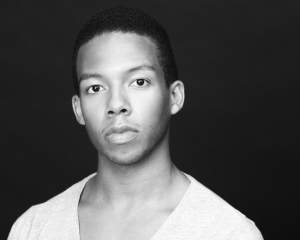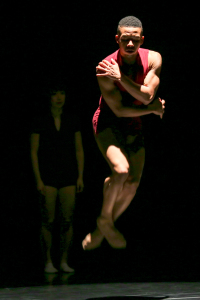
Greg Blackmon is a new choreographer and DanceWorks Chicago alum. DanceWorks Chicago was founded in 2007 and gives early career artists an environment where they can build a foundation and hone their artistry through training, collaboration, performances and mentoring opportunities. They also showcase work from established choreographers.
Greg recently choreographed “PACK: And for All the Lost Ones” for DanceChance, a showcase which features choreographers chosen by chance. Afterwards, his piece was taken into the DWC repertoire – marking the first time that DWC dancer has become a DWC choreographer.
“PACK: And for All the Lost Ones” will make its premiere with DWC on Sunday, November 16 at DanceMoves.
What inspired your piece “Pack: And for All the Lost Ones”?
The piece is actually about a friend of mine and former DWC dancer, Marco Antonio Huicochea Gonzalez, who passed away during his time with us. It was a really rough loss for all of us, and after a few months of reflection I decided I would like to honor him through the art form we got to share with one another. So I dropped my name into the fishbowl at Dance Chance and wound up getting selected, which allowed this idea to come to fruition.
What music did you chose for this piece?
I chose a song by an Icelandic band called Sigúr Ros, “All Alright.” I’d heard it when a friend of mine used it years before for a piece of his own and I’ve always been in love with the juxtaposition of the music’s reflective, emotional tone and its instrumental minimalism.
What style is “Pack: And for All the Lost Ones”?
I would consider the piece to be contemporary. I’ve implemented some ballet principles, but re-imagined and reconfigured them to fit more organic movement.
What is your choreographic process like?
Since I’m just starting out, I think I’ll say my process from piece to piece will be different every time. I like to believe every task– not just in dance, but in life in general– has a formula specific to itself that will breed the most success in terms of what your goals are. This piece started with me taking a lot of note from the emotional displays of animals, mainly dogs/wolves, and fusing that honesty and the body language with styles of contemporary movement that I love.
When did you find out that “Pack: And for All the Lost Ones” was going to be added to the DWC rep?
A few weeks after Julie saw the piece at Dance Chance, she asked if Matt (the other original dancer and a current DWC company member) and I would like to perform “Pack…” at the Dance for Life kickoff gala this summer, which was exciting in itself because so many people that I admire in the dance world got to see it. And then about 3 or 4 weeks after that, Julie asked if we could meet to discuss how it would work its way into the DWC repertoire.
How did you feel when found this out?
I was absolutely ecstatic! This was my first creation as a professional choreographer, and I didn’t even aspire for it to be anything more than what it was– a short, sweet dedication to a very dear friend and to the family that I’ve found in DanceWorks Chicago, as well as a sort of memorial for everyone who’s ever been lost from this world (because everyone means something to someone. And everyone is loved very dearly by someone.). And it’s grown into something that a ton of other people will get to see and hold dear to their hearts because of one idea that I had.
What did you learn during your time at DanceWorks Chicago and how has it helped you?
I could write a book on everything that I’ve learned here. One of the most important things is that you really are a person first and THEN an artist. I think a lot of dancers can get really caught up in the idea of this art form we dedicate our lives to and all of the prestige surrounding the mental and physical dedication it takes, and we forget that we have to be people inside of the movement. Otherwise, you’re just someone else who can throw a leg up or point your foot and pretend to say something, or imply an idea, but never really say anything…never really give it meaning.
I’ve also learned to be more patient and a bit less of a perfectionist. I’ll never forget Julie Nakagawa pulling me aside one day while we were on your and telling me “Just do the work. Don’t fuss or obsess about the mistakes. Just… do… the work. That’s really all anyone can ask of you. But you have to really do it.”

What are some of your dance goals and dreams for the future?
I think my biggest dream for the future is to continue exploring movement and manifesting both my own ideas and the ideas of others through dance. It’s so much fun translating something as abstract as a simple thought into something as tangible as dance. And I love knowing that the things I can put on a stage will touch each audience member in a way that’s unique to them and their experience, because that’s what art does. It stirs people in a multitude of ways and the beauty of it lies in the undeniable sincerity of their response.




